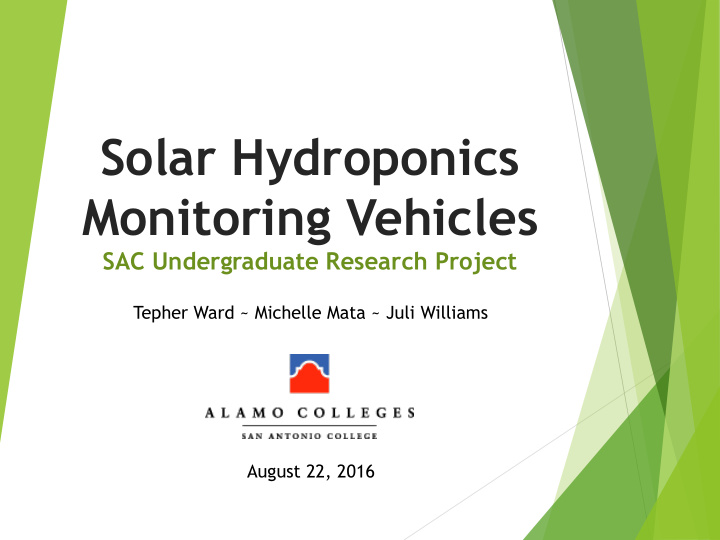



Solar Hydroponics Monitoring Vehicles SAC Undergraduate Research Project Tepher Ward ~ Michelle Mata ~ Juli Williams August 22, 2016
Team Members Tepher Ward – Team Lead; Mechanical Design Michelle Mata – V1 Arduino Programmer Juli Williams – V2 Raspberry Pi Programmer
Introduction to Hydroponics Soilless farming Shipping container is 320 sq. ft. Controlled environment ReEnergize initiatives
Requirements Solar Hydroponics Team Remote control Data tracking via WiFi Environmental Temperature ranges from 70 – 90 F Humidity ranges from 60% - 80% ReEnergize Program Cost-efficient Adaptable for future enhancements
Project Goal The Hydroponics Monitoring Vehicles team set out to construct and compare two vehicles to determine which would be better suited to meet all needs, including end-user, environmental, and program requirements.
Design for V1 Construction Tetrix parts Tetrix motors Electronics Arduino UNO WiFi Shield 101 Motor driver Programming Windows Arduino IDE Arduino libraries
Design for V2 Construction Hardware store parts Tetrix motors Electronics Raspberry Pi (RPi) Motor driver Programming Linux Minibian Apache
Results for V1 Construction Constraints of components Durability of parts Electronics Sufficient drivers Programming Arduino pin overrides Shield limitations
Results for V2 Construction Adaptability of components Durability of parts Balance and weight distribution Electronics Sufficient drivers Programming Web-accessible controls Controlled stops
Conclusions and Findings End-user Requirements Met Both V1 and V2 Environmental Requirements Met Both V1 and V2 Program Requirements Met Arduino and Raspberry Pi V2 More Structurally Adaptable and Flexible V2 More Cost-efficient ($170 vs $420 for materials)
The Future of SAC’s RC -HMVs Line sensors Swivel-mounted front camera Better traction and weight distribution Data tracking via WiFi Camera hoisting mechanism Moisture-proof A cool name and logo!
Acknowledgements Team Advisors and Supports Mr. Steven Lewis – Director of Eco Ms. Barbara Knotts – Adelante Tejas Project Centro, Project Advisor Grant Director Mr. Klaus Bartels – Adjunct Faculty, Ms. Patty Medina – Exitos Grant Director Physics, Engineering, and Architecture Ms. Dee Dixon – MESA Center Coordinator Department, Project Advisor Ms. Sylvia San Miguel – Administrative Assistant Mr. Ben Uresti – Academic Lab Technician for the MESA Center, Technical Ms. Susan Paddock – LSAMP/CIMA Grant Co-PI Advisor Ms. Susan Espinoza – Director of College Grants Ms. Bly Korseau – Engineering and Development Administrative Assistant Dr. Robert Vela – SAC President Sponsors
Questions?
Recommend
More recommend